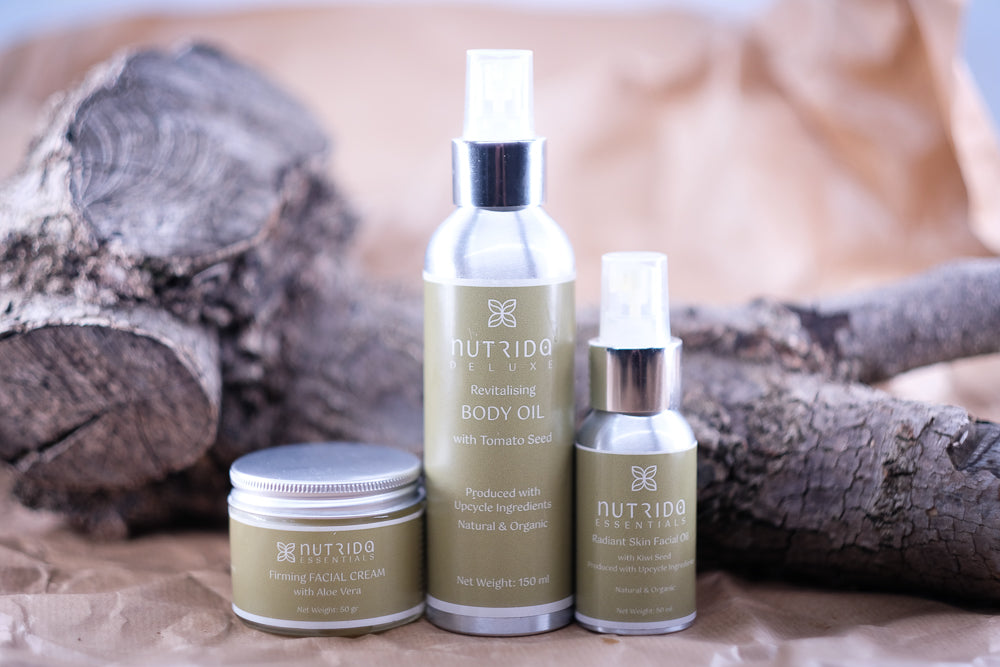
Nutrida Essentials Upcycle: Upcycling Waste Solutions on Skincare
Share
Upcycling Waste Solutions on Skincare
In recent years, the importance of sustainability has permeated various sectors, including skincare. As consumers become more conscientious about their choices, the focus has shifted toward upcycling waste solutions on skincare. This innovative approach not only promotes eco-friendliness but also enhances the quality of skincare products by harnessing the potential of what was once discarded. By adopting a mindset that values resourcefulness, brands are actively transforming how we perceive waste within the beauty industry.
Upcycling waste refers to the process of taking materials that are often considered trash and repurposing them into new, valuable products. In the realm of skincare, this means utilizing leftover ingredients from food production, agricultural practices, and other industries to create potent skincare formulations. The practice not only reduces the carbon footprint associated with producing new ingredients but also fosters a new era of creativity within the beauty sector.
Take, for example, the extraction of oils from fruit seeds and peels, which are often discarded during processing. These oils are rich in antioxidants, vitamins, and fatty acids that are beneficial for the skin. By upcycling these by-products into skincare products, brands are minimizing waste while providing consumers with high-quality ingredients. This process showcases the value of what is often overlooked, demonstrating that sustainability and efficacy can coexist harmoniously.
Moreover, upcycling waste solutions on skincare allow brands to tell a story that resonates with eco-conscious consumers. When consumers understand the origin of the ingredients in the products they use, they are more likely to form a deeper connection with the brand. This connection fosters brand loyalty and encourages customers to make more sustainable choices in their purchasing decisions.
In the current market, several brands are leading the charge in this space by embracing upcycled ingredients. For instance, some companies utilize coffee grounds, which are a common waste product, to formulate exfoliating scrubs. Coffee grounds have natural exfoliating properties that help remove dead skin cells while promoting circulation. Additionally, brands are employing grape seeds, which are often a by-product of winemaking, to create nourishing oils that are rich in antioxidants.
Another compelling example of upcycling waste solutions on skincare is the use of rice bran. Rice is a staple food for a significant portion of the global population, and the bran that is left over after milling can be transformed into a powerful ingredient for skincare. Rich in vitamins E and B, rice bran oil is known for its moisturizing and antioxidant qualities. Several brands have harnessed this by-product and incorporated it into their formulations, aligning with the movement towards sustainability.
Upcycling doesn’t just stop at ingredients; it also extends to packaging. Many brands are exploring ways to utilize recycled materials in their product packaging, further reducing waste and promoting a circular economy. By prioritizing sustainable packaging, brands not only enhance their eco-credentials but also appeal to consumers who are increasingly looking for environmentally friendly options.
However, the journey towards upcycling waste solutions on skincare isn't without its challenges. It requires innovation and creativity to find effective uses for various waste materials. Additionally, there can be regulatory hurdles to overcome when introducing new ingredients to the market. Brands must ensure that their upcycled ingredients meet safety and efficacy standards, necessitating rigorous testing and validation.
Despite these challenges, the rewards of upcycling in skincare are substantial. As the demand for sustainable and clean beauty products continues to rise, brands that embrace upcycling will likely gain a competitive edge. Moreover, consumers are becoming more informed and are seeking transparency in the brands they support. By sharing their commitment to sustainability and upcycling, brands can differentiate themselves in a crowded marketplace.
Education is key in promoting upcycling waste solutions on skincare. Brands can take proactive measures to educate consumers about the benefits of upcycled ingredients. This can be achieved through informative content, social media campaigns, and collaborations with influencers who are champions for sustainability. By providing insights into the upcycling process, brands can demystify the practice and encourage consumers to embrace products with upcycled ingredients.
As we look to the future, the potential for upcycling waste solutions in skincare is immense. With ongoing research and innovation, we can expect to see more brands embracing this holistic approach. The beauty industry has an opportunity to evolve into a more sustainable model, reducing waste while enhancing the quality of products available to consumers.
Ultimately, the integration of upcycling waste solutions on skincare represents a shift in mindset—a recognition that waste can be transformed into something beautiful and beneficial. By choosing products that incorporate upcycled ingredients, consumers not only make a positive impact on the environment but also support a movement that values creativity, sustainability, and innovation. In this way, we can all play a role in promoting a healthier planet while enjoying the benefits of effective skincare.
